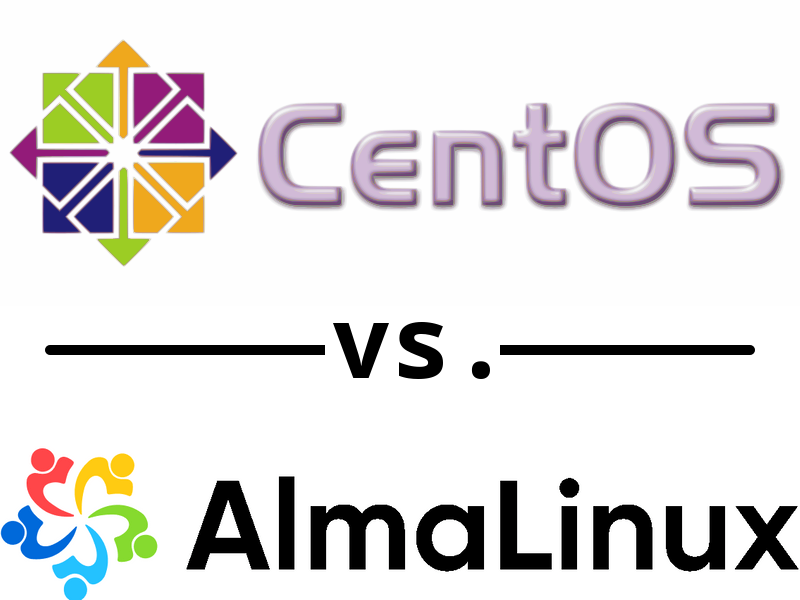
Table of Contents
CentOS vs Alma Linux are both popular Linux distributions, particularly in server environments. However, they have distinct backgrounds, purposes, and features. Here’s a comparison between the two:
Overview
- CentOS: CentOS (Community ENTerprise Operating System) was a free, community-supported Linux distribution that provided a stable and reliable platform by rebuilding the source packages from Red Hat Enterprise Linux (RHEL). CentOS Stream, introduced by Red Hat, is a rolling-release distribution that sits between Fedora (cutting-edge) and RHEL (stable).
- AlmaLinux: AlmaLinux is a free, open-source, community-driven Linux distribution designed to be a 1:1 binary-compatible fork of RHEL. It was created as a direct replacement for CentOS, particularly for those who preferred the traditional, stable releases of CentOS before the shift to CentOS Stream.
Key Differences of CentOS vs Alma Linux
- Purpose and Use Cases:
- CentOS:
- CentOS Stream: Intended for developers who want to contribute to RHEL or get early access to the packages that will be included in the next minor RHEL release. It’s not a direct replacement for the stable CentOS of the past.
- CentOS Linux (Deprecated): Previously used in production environments for its stability, being an exact copy of RHEL without the cost. However, this version is no longer actively developed or supported as of December 2021.
- AlmaLinux:
- Designed to fill the gap left by CentOS Linux. It’s intended for production environments that require a stable, RHEL-compatible operating system without the rolling-release nature of CentOS Stream.
- AlmaLinux is supported by the AlmaLinux OS Foundation, which includes major companies and contributors, ensuring its long-term viability.
- CentOS:
- Development and Support:
- CentOS:
- CentOS Stream: Maintained by Red Hat and the broader community. It’s a continuously updated distribution that showcases what the next RHEL minor release will look like.
- Support: CentOS Stream has support aligned with the RHEL release schedule but may not be as suitable for mission-critical production environments due to its rolling-release nature.
- AlmaLinux:
- Maintained by the AlmaLinux OS Foundation, which includes a community of developers and corporate sponsors.
- Support: AlmaLinux provides long-term support (LTS) aligned with RHEL’s release schedule. It offers a stable platform suitable for production environments.
- CentOS:
- Release Cycle:
- CentOS:
- CentOS Stream: Rolling release with continuous updates. Users will see changes and updates before they make it into RHEL.
- AlmaLinux:
- Follows RHEL’s release cycle closely, with regular point releases and security updates, making it predictable and reliable for production use.
- CentOS:
- Community and Ecosystem:
- CentOS:
- Strong historical community backing, but the shift to CentOS Stream has led some users to migrate to alternatives like AlmaLinux or Rocky Linux.
- Part of the Red Hat ecosystem, making it closely tied to RHEL developments.
- AlmaLinux:
- Gaining a strong community following, especially among former CentOS users seeking a stable RHEL-compatible distribution.
- Supported by a growing ecosystem of tools, support, and documentation, including enterprise-level support options.
- CentOS:
- Migration:
- CentOS:
- Migration from CentOS Linux (7 or 8) to CentOS Stream is relatively straightforward, but it changes the nature of the release cycle.
- AlmaLinux:
- Provides easy migration tools for users moving from CentOS 7 or 8 to AlmaLinux. The
ELevate Projectoffers in-place upgrades across major versions.
- Provides easy migration tools for users moving from CentOS 7 or 8 to AlmaLinux. The
- CentOS:
- Stability:
- CentOS Stream: May experience more frequent changes, making it less ideal for environments requiring strict stability.
- AlmaLinux: Prioritizes stability and is designed to be used in production environments where reliability is critical.
Similarities Between CentOS vs Alma Linux
- Downstream from RHEL: Both AlmaLinux and CentOS are downstream distributions of Redhat Enterprise Linux.
- 10-year lifetime: AlmaLinux and CentOS both have a 10-year lifespan to receive software updates from their initial release date.
- Community-driven: CentOS project and the AlmaLinux foundation are similarly structured. Both are community-driven and backed by companies that have experience in deploying enterprise-grade operating systems.
- Price: Both CentOS and AlmaLinux are made free to use and have no fees associated with using them.
- Package Management: Software packages for both distributions are in RPM format. RPMs are installed and updated by the DNF utility on CentOS 8 and AlmaLinux 8.
Conclusion
- CentOS Stream is suited for users who want to stay ahead of the curve with RHEL and participate in the development process, but it may not be ideal for those needing a stable, long-term production environment.
- AlmaLinux is an excellent choice for users looking for a CentOS Linux replacement with the same stability and predictability. It’s particularly appealing for businesses and organizations that need a reliable, enterprise-grade operating system without the costs associated with RHEL.
For most users and enterprises that relied on the old CentOS vs Alma Linux (or other alternatives like Rocky Linux) will be the better option, providing the stability and support they require.